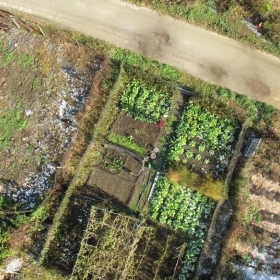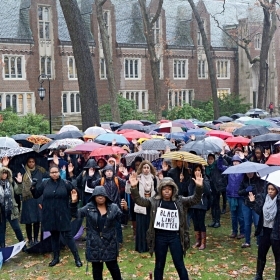As I write, a busy and full semester is winding down. As you are well aware, several College issues garnered widespread attention in our Wellesley community and beyond this fall. In some ways, it was...
As I write, a busy and full semester is winding down. As you are well aware, several College issues garnered widespread attention in our Wellesley community and beyond this fall. In some ways, it was a challenging semester: Conversations that were meant for the Wellesley family ended up with a public spotlight on them—and misinformation spread quickly.
Whether it was a discussion on our process for exploring Wellesley and gender, or changes to our Jewish chaplaincy to strengthen the support for Jewish students on campus; whether it was a dialogue on the disposition of the North 40, or a look at race relations at Wellesley, it is clear that our College community is deeply invested in, and a part of, the difficult but important conversations that will shape the future of the College—and strengthen it.
How do we ensure the future strength of Wellesley? We rededicate ourselves to our diverse community: Our incredible, creative, and thoughtful alumnae, students, faculty, and staff are what make this place so special. And we rededicate ourselves to the core of the liberal arts, as well as to the important role we play as a women’s college—the best women’s college in the world. The liberal arts encourage us to have the courage to explore, the confidence to test boundaries, and, ultimately, the strength and ability to make a difference in the world. Being a women’s college intensifies this effect.
There are endless stories that capture this spirit of Wellesley. Let me share just a few from our students and recent graduates.
‘Wellesley, our Wellesley, is and always will be a magical place for women to become, as I often like to say, the very best versions of themselves.’
—H. Kim Bottomly
Maria LaBouyer ’15 is using her biology major to engage in groundbreaking research—exploring the connection between gastrointestinal disease and autism. As part of chemistry professor Don Elmore’s lab, she already has contributed to studies on antimicrobial peptides. “The undergraduate research opportunities at Wellesley are phenomenal,” she says. So are the opportunities to be part of an engaged community. “I was recruited to play softball,” she explains, “but what made me choose Wellesley over a Division I school was the community. … I have continued to embrace the Wellesley community and the sisterhood it fosters, as well as the amazing relationships with professors.”
Meanwhile, recent graduate Michaela Haffner ’14 is interested in further exploring the intersection of art history and medicine. From an early age, Michaela has been curious about the depictions of health, illness, and anatomy in works of art, and she believes that art analysis can be used as a means of training doctors in patient observation. This interest inspired her senior thesis, in which she examined Édouard Vuillard’s 19th century works in the context of growing societal fears about infectious disease. Michaela has spent this fall as the Liliane Pingoud Soriano Curatorial Research Fellow at the Louvre in Paris.
And in Mainilli, India—a small village that is literally not on the map—Jessica Saifee ’16 spent a semester doing public-health research on the Siddi community. “Mainilli gave me the opportunity to step outside of my comfort zone. The experience galvanized my desire to work in rural areas,” she says. Spending time in the village made her appreciate the opportunities she has been given, and she has rededicated herself to helping others. In addition to her public-health research, she set aside time to tutor students in English and chemistry. “They were inspirational to me because of how dedicated they were,” she says.
Maria, Michaela, and Jessica—and all the stories of students and alumnae in this very magazine—remind us that Wellesley, our Wellesley, is and always will be a magical place for women to become, as I often like to say, the very best versions of themselves.
Everybody has a story to tell. And Wellesley has so many good ones to tell. Thank you for contributing to the Wellesley story.


